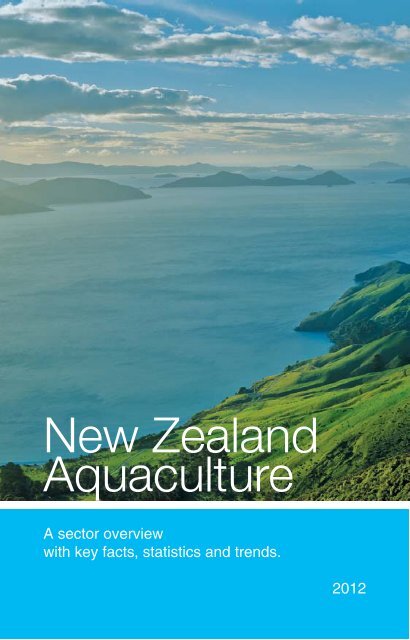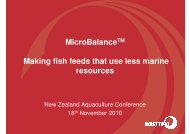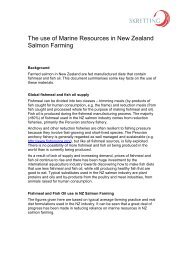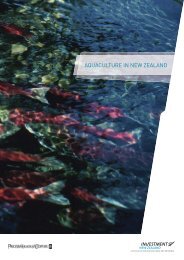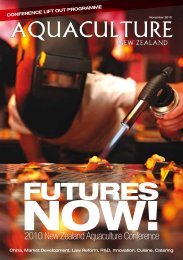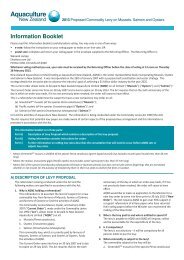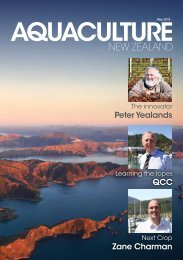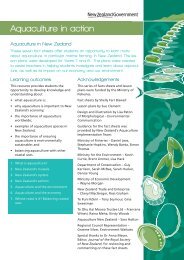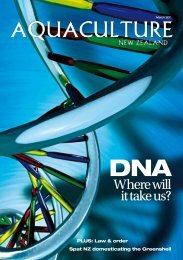AQU 8016 Facts#5 - Aquaculture New Zealand
AQU 8016 Facts#5 - Aquaculture New Zealand
AQU 8016 Facts#5 - Aquaculture New Zealand
You also want an ePaper? Increase the reach of your titles
YUMPU automatically turns print PDFs into web optimized ePapers that Google loves.
�����������<br />
�����������<br />
A sector overview<br />
with key facts, statistics and trends.<br />
2012
In the past 40 years aquaculture in <strong>New</strong> <strong>Zealand</strong> has grown<br />
from very small beginnings to a significant primary industry,<br />
currently estimated to have a revenue in excess of $400<br />
million, with a target goal of reaching $1 billion in sales by<br />
2025.<br />
Just as <strong>New</strong> <strong>Zealand</strong>’s distinctive land creates outstanding<br />
wines, our seas nurture superb seafood. The natural purity<br />
of our water, our unique marine ecology and our small<br />
population unify to create seafood of unmatched quality and<br />
taste.<br />
In today’s hectic world people yearn for sensory experiences<br />
that can transport them to a place where nature rules supreme.<br />
The integrity of flavour and quality of our flagship aquaculture<br />
species including <strong>New</strong> <strong>Zealand</strong> Greenshell Mussels,<br />
King Salmon and Pacific Oysters deliver just that.
Major <strong>Aquaculture</strong> Areas in <strong>New</strong> <strong>Zealand</strong><br />
Northland<br />
Pacific Oyster:<br />
51% of total production<br />
Auckland<br />
Greenshell Mussel:<br />
4% of total production<br />
Pacific Oyster:<br />
25% of total production<br />
Tasman & Golden Bays<br />
Greenshell Mussel:<br />
3% of total production<br />
Coromandel<br />
Greenshell Mussel:<br />
19% of total production<br />
Pacific Oyster:<br />
21% of total production<br />
Marlborough<br />
Greenshell Mussel:<br />
69% of total production<br />
King Salmon:<br />
64% of total production<br />
Pacific Oyster:<br />
3% of total production<br />
Canterbury<br />
Greenshell Mussel:<br />
2% of total production<br />
King Salmon:<br />
4% of total production<br />
Southland<br />
Greenshell Mussel:<br />
3% of total production<br />
King Salmon:<br />
32% of total production<br />
Source: <strong>Aquaculture</strong> <strong>New</strong> <strong>Zealand</strong> Levy Production 2011<br />
�
Environmental Sustainability<br />
<strong>New</strong> <strong>Zealand</strong> marine farmers continually push the boundaries of global<br />
best practice to meet the growing global demand for safe, healthy<br />
and environmentally sustainable seafood products. Species specific<br />
Environmental Codes of Practice direct best industry practices<br />
throughout growing and harvesting to minimise potential effects on<br />
the environment.<br />
Independent recognition of the <strong>New</strong> <strong>Zealand</strong> aquaculture sector’s<br />
commitment to environmental sustainability has come from international<br />
conservation organisation Blue Ocean Institute, who have ranked<br />
<strong>New</strong> <strong>Zealand</strong> Greenshell Mussels as one of the top ‘eco-friendly’<br />
seafoods in the world.<br />
Global Trust Certification Ltd have also recognised the world leading<br />
environmental practices in the farming of King Salmon in <strong>New</strong> <strong>Zealand</strong>.<br />
“The <strong>New</strong> <strong>Zealand</strong> salmon industry achieves a first class rating amongst<br />
global producers. Born out of inherent resource based attributes<br />
displayed by the natural marine environment in combination with a<br />
highly dedicated, quality focused sector, <strong>New</strong> <strong>Zealand</strong> salmon is<br />
synonymous with the words healthy, pure and natural. Farms are<br />
compliant to one of the most robust regulatory frameworks in the<br />
world, developed through partnership and choice.”<br />
Global Trust Certification Ltd.<br />
Water Quality<br />
<strong>New</strong> <strong>Zealand</strong> operates one of the strictest quality assurance<br />
programmes for shellfish in the world, testing both the shellfish and<br />
the water in which it grows. Water quality is rigorously and constantly<br />
monitored with testing carried out to specifications and standards set<br />
by the U.S Food and Drug Administration, European Union and<br />
NZ Food Safety Authority. Under this stringent monitoring programme<br />
no shellfish product can be harvested from farms without confirmation<br />
that water testing during the growing cycle, rainfall monitoring and<br />
product testing has declared it as safe.<br />
In <strong>New</strong> <strong>Zealand</strong>, site selection for the growing of King Salmon is based<br />
on a pristine and unpolluted rearing environment. Farms are strategically<br />
positioned in remote areas with strong tidal flow. The temperature and<br />
purity of the water is critical and the sun, wind and tides assist in<br />
cleaning the cages. Fish need a plentiful supply of well-oxygenated<br />
and unpolluted water. A good depth of water allows adequate space<br />
between net and seabed; a good water flow ensures a constant supply<br />
of dissolved oxygen and maintains the water quality.<br />
�
Nature’s Superfood<br />
Packed with natural goodness, our products offer a wealth of nutritional<br />
benefits.<br />
<strong>New</strong> <strong>Zealand</strong> Greenshell Mussels<br />
<strong>New</strong> <strong>Zealand</strong> Greenshell Mussels are the ultimate health food. High<br />
in protein, low in fat yet providing 680mg of omega-3 from EPA and<br />
DHA in one serving. They are also a rich source of selenium, iron,<br />
Vitamin B12 and iodine, and a good source of magnesium and calcium.<br />
Five <strong>New</strong> <strong>Zealand</strong> Greenshell Mussels provide almost 100% of your<br />
daily iodine and selenium needs, 1/3 of daily protein needs and almost<br />
three times your daily Vitamin B12 needs.<br />
<strong>New</strong> <strong>Zealand</strong>’s King Salmon<br />
King (Chinook) Salmon has one of the highest natural oil contents of<br />
all salmon varieties. Containing high protein and very low sodium<br />
levels, King Salmon is also an excellent source of selenium,<br />
Vitamin B6, Vitamin B12 and Vitamin D.<br />
One serving of King Salmon (110g raw) provides 2500 mg of EPA and<br />
DHA omega-3 fats which are essential for good health.<br />
<strong>New</strong> <strong>Zealand</strong> Pacific Oysters<br />
Pacific Oysters are rich in zinc, iron and Vitamin B12, with 5-6 oysters<br />
providing over three times your daily Vitamin B12, 100% of your daily<br />
zinc needs, 30% of daily iron needs and 1500mg of EPA and DHA<br />
omega-3 fats.<br />
Pacific Oysters are also high in protein and an excellent source of<br />
copper, iodine, magnesium, selenium and Vitamin C, and a good<br />
source of Vitamin D.<br />
�
�<br />
<strong>Aquaculture</strong> in <strong>New</strong> <strong>Zealand</strong><br />
As of December 2011, aquaculture activities in <strong>New</strong> <strong>Zealand</strong> take<br />
place within approximately 19,268ha of allocated water space.<br />
Of this:<br />
• 7,743 ha is granted to the aquaculture industry with the right to<br />
farm for a defined term, and is in known productive growing areas<br />
• 8,960 ha are open-ocean sites where productivity is yet to be<br />
proven<br />
• 1,195 ha are near shore sites yet to be developed<br />
• 1,370 ha is undeveloped space in interim AMA’s<br />
Source: Fish Farm Register, Ministry of Fisheries<br />
<strong>Aquaculture</strong> Trends & Information<br />
The aquaculture sector is the fastest growing animal protein<br />
producing sector.<br />
The Food & Agriculture Organization (FAO) estimates that global<br />
aquaculture production will continue to increase, reaching nearly<br />
74 million tonnes in 2020.<br />
The growth in global fish protein consumption to 2020 will be from<br />
emerging economies.<br />
An industry drive, supported by government, is assisting the sector<br />
to move towards higher value propositions that promise to be the<br />
future of aquaculture in <strong>New</strong> <strong>Zealand</strong>.<br />
Sustainable aquaculture makes a significant contribution to<br />
<strong>New</strong> <strong>Zealand</strong>’s economy. Currently offering employment to over<br />
3,000 people, this figure is expected to increase in the coming<br />
years.
<strong>New</strong> <strong>Zealand</strong> <strong>Aquaculture</strong> Statistics<br />
Production and revenue metrics for 2011<br />
Mussels Salmon Oysters<br />
Harvested product<br />
(greenweight tonnage)<br />
101,311 14,037 1,804<br />
Export revenue NZ$ (millions) 218.1 63.4 16.6<br />
Domestic revenue NZ$ (millions)<br />
(estimated)<br />
35.0 65.0 8.0<br />
Due to a lack of robust domestic consumption information being<br />
available for the three species, a focus has been placed on presenting<br />
an analysis around the export statistics. These are official export<br />
figures collected by <strong>New</strong> <strong>Zealand</strong> Customs. All export revenue<br />
information is reported in FoB (Free on Board) pricing.<br />
<strong>New</strong> <strong>Zealand</strong> <strong>Aquaculture</strong> Exports<br />
<strong>Aquaculture</strong> exports in 2011 equated to NZ$298 million.<br />
<strong>New</strong> <strong>Zealand</strong> had 79 active export markets in 2011 for<br />
Greenshell Mussels, Pacific Oysters and King Salmon.<br />
Proportion of aquaculture exports for 2011 by Volume<br />
Source: <strong>New</strong> <strong>Zealand</strong> Seafood Exports 2011<br />
Oysters (4%) 1,667 tonnes<br />
Salmon (11%) 5,166 tonnes<br />
Mussels (85%) 38,143 tonnes<br />
Proportion of aquaculture exports for 2011 by Value<br />
Source: <strong>New</strong> <strong>Zealand</strong> Seafood Exports 2011<br />
Oysters (6%) NZ$16.6 million<br />
Salmon (21%) NZ$63.4 million<br />
Mussels (73%) NZ$218.1 million<br />
�
�<br />
<strong>Aquaculture</strong> exports over time<br />
Export values (NZ$million)<br />
300<br />
250<br />
200<br />
150<br />
100<br />
50<br />
Oysters Salmon Mussels<br />
1989 1991 1993 1995 1997 1999 2001 2003 2005 2007 2009 2011<br />
Source: <strong>New</strong> <strong>Zealand</strong> Seafood Exports
<strong>New</strong> <strong>Zealand</strong><br />
Greenshell<br />
Mussels<br />
�
�<br />
<strong>New</strong> <strong>Zealand</strong> Greenshell Mussels<br />
<strong>New</strong> <strong>Zealand</strong>’s isolation makes it a natural home for many unique<br />
species. One of the most sought after by seafood lovers the world<br />
over, is <strong>New</strong> <strong>Zealand</strong> Greenshell Mussels.<br />
Nurtured in the clear, sunlit waters around <strong>New</strong> <strong>Zealand</strong>’s unspoiled<br />
coastline, these mussels thrive on a constant flow of nutrients. Under<br />
careful stewardship, they mature into plump, full-flavoured mussels<br />
that lend themselves to numerous styles of international cuisine.<br />
From appealing finger-food to succulent main-meal occasions,<br />
<strong>New</strong> <strong>Zealand</strong> Greenshell Mussels are masters of versatility. They<br />
are healthy, satisfying and easy to prepare.<br />
In many cases, we snap-freeze them to capture all the fresh flavour<br />
and the nutritional value they had as they emerged from the water.<br />
In <strong>New</strong> <strong>Zealand</strong> we owe a lot to nature, therefore we are careful to<br />
preserve our natural gifts. Hence our insistence on world leading<br />
water quality management and other key environmental benchmarks.<br />
We are acutely aware that the world wants food that not only tastes<br />
wonderful but carries with it firm assurances around food integrity.<br />
In all these respects, <strong>New</strong> <strong>Zealand</strong> Greenshell Mussels shine as<br />
rare and precious culinary gems from the South Pacific.
�����������������������������������<br />
������������������������������������������<br />
<strong>New</strong> <strong>Zealand</strong> Greenshell Mussels (Perna canaliculus) are a<br />
native <strong>New</strong> <strong>Zealand</strong> shellfish.<br />
Mussels are filter feeders, meaning they literally filter their food<br />
from the sea by pumping the water through their gills. A typical<br />
mussel filters 360 litres or 95 U.S gallons of water each day.<br />
Although no difference in quality or flavour, the colour of the mussel<br />
meat varies according to sex. The female is a deep apricot and<br />
the male a soft cream.<br />
<strong>New</strong> <strong>Zealand</strong> Greenshell Mussels can be grown to market size<br />
in 12-18 months from final seeding.<br />
<strong>New</strong> <strong>Zealand</strong> Greenshell Mussels will grow in temperatures<br />
between 12° - 24°C, thriving most in temperatures between<br />
16° - 19°C (61°F - 66°F).<br />
<strong>New</strong> <strong>Zealand</strong> Greenshell Mussel Export Statistics<br />
<strong>New</strong> <strong>Zealand</strong> Greenshell Mussels were exported to 78 countries<br />
in 2011.<br />
The predominant Greenshell Mussel product exported by the<br />
industry is the IQF (individually quick frozen) half shell format. In<br />
2011, 83% (37,871 tonnes) of mussels were exported in this IQF<br />
format.<br />
The Top Five Mussel Export Markets by Value in 2011<br />
Hong Kong NZ$12.6 m<br />
Spain NZ$18.6 m<br />
Australia NZ$22.3 m<br />
South Korea NZ$22.9 m<br />
US NZ$72.6 m<br />
�
��<br />
<strong>New</strong> <strong>Zealand</strong> Greenshell Mussel exports 2011<br />
Product category Export weight (kgs) % of exports<br />
Half Shell Frozen 31,871,216 83.55%<br />
Meat Frozen 3,710,374 9.72%<br />
Whole Frozen 1,388,032 3.64%<br />
Preserved/Marinated 490,252 1.29%<br />
Freeze-dried Powder 251,928 0.66%<br />
Live 248,428 0.65%<br />
Processed in Can, Jar 82,508 0.22%<br />
Other not Live/Chilled/Frozen 30,345 0.08%<br />
Powder in capsule 25,74 0.07%<br />
Whole Chilled 15,030 0.04%<br />
Smoked 10,464 0.03%<br />
Crumbed, battered 8,060 0.02%<br />
Meat Chilled/Fresh 6,923 0.02%<br />
Half Shell Fresh/Chilled 3,756 0.01%<br />
Source: <strong>New</strong> <strong>Zealand</strong> Seafood Exports 2011
<strong>New</strong> <strong>Zealand</strong><br />
Pacific<br />
Oysters<br />
��
��<br />
<strong>New</strong> <strong>Zealand</strong> Pacific Oysters<br />
No other food reflects its origins as swiftly and sensually as an oyster<br />
to its seaborne home. When that home happens to be in <strong>New</strong> <strong>Zealand</strong>’s<br />
unspoiled coastal waters and the oyster is a <strong>New</strong> <strong>Zealand</strong><br />
Pacific Oyster, that pleasurable experience is only accentuated.<br />
The unique characteristics of our pure underwater environment and<br />
distinctive marine ecology impart a clean flavour profile and full-bodied<br />
texture to our Pacific Oysters. Taste experiences appreciated and<br />
recalled by oyster lovers everywhere.<br />
We often snap-freeze our raw oysters immediately at harvest to ensure<br />
consumers around the world can enjoy them at their peak of flavour<br />
and nutritional value. They have the same taste sensation as<br />
non-frozen raw oysters but have the added benefit of greater<br />
convenience. No small consideration in this time-pressured world.<br />
Consumers of <strong>New</strong> <strong>Zealand</strong> Pacific Oysters can be confident that<br />
what they are enjoying won’t be compromised in any way by safety<br />
concerns. <strong>New</strong> <strong>Zealand</strong> takes pride in maintaining the strictest quality<br />
assurance programme in the world. While most countries test either<br />
the shellfish or the immediate seawater environment, <strong>New</strong> <strong>Zealand</strong><br />
rigorously and regularly tests both. The impact of all these measures<br />
mean that <strong>New</strong> <strong>Zealand</strong> Pacific Oysters can be fully appreciated<br />
worldwide in their natural raw state.
��������������������������������������<br />
The scientific name for Pacific Oysters is (Crassostrea gigas).<br />
Pacific Oysters are filter feeders, and at adult size (80-100mm in<br />
length) may filter up to 240 litres or 63 U.S gallons daily.<br />
For best growth results, Pacific Oysters thrive in temperatures<br />
between 15° - 18°C (59°F - 64°F).<br />
In <strong>New</strong> <strong>Zealand</strong>, Pacific Oysters can be grown to market size<br />
(around 80-100mm) within 12–18 months.<br />
Pacific Oysters may change sex more than once during their life<br />
span, usually spawning first as a male and subsequently as a<br />
female.<br />
<strong>New</strong> <strong>Zealand</strong> Pacific Oyster Export Statistics<br />
In 2011 <strong>New</strong> <strong>Zealand</strong> Pacific Oysters were exported into 24 countries.<br />
The predominant Pacific Oyster product exported by the industry is<br />
the IQF (individually quick frozen) half shell format. In 2011,<br />
87% (1,454 tonnes) of Pacific Oysters were exported in this IQF<br />
format.<br />
The Top Five Oyster Export Markets by Value in 2011<br />
French Polynesia NZ$0.3m<br />
<strong>New</strong> Caledonia NZ$0.8m<br />
Japan NZ$1.9m<br />
Hong Kong NZ$1.9m<br />
Australia NZ$10.6m<br />
��
��<br />
<strong>New</strong> <strong>Zealand</strong> Pacific Oyster exports 2011<br />
Product category Export weight (kgs) % of exports<br />
Oysters Frozen Half Shell 1,453,530 87.21%<br />
Oysters Chilled Half Shell 74,633 4.48%<br />
Oysters Chilled Whole 68,289 4.16%<br />
Oysters Live Chilled 48,900 2.93%<br />
Oysters Frozen Whole 9,350 0.56%<br />
Oysters Chilled Meat 5,170 0.31%<br />
Oysters Frozen Meat 4,130 0.25%<br />
Oysters Other forms 1,028 0.06%<br />
Oysters prepared can, jar 589 0.04%<br />
Source: <strong>New</strong> <strong>Zealand</strong> Seafood Exports 2011
<strong>New</strong> <strong>Zealand</strong>’s<br />
King Salmon<br />
��
��<br />
<strong>New</strong> <strong>Zealand</strong>’s King Salmon<br />
The surest way to produce superb eating salmon is to raise them in<br />
natural surroundings where the water is pure and food safety is<br />
assured.<br />
<strong>New</strong> <strong>Zealand</strong>’s remote waters, meticulous farming practices and our<br />
strict bio-security procedures mean that we produce our salmon in<br />
the most healthy and environmentally sustainable manner with complete<br />
product integrity.<br />
Of course, it also helps when you start out with a species as desirable<br />
as King Salmon. <strong>New</strong> <strong>Zealand</strong>’s King Salmon offers an exceptional<br />
taste, the result of a premium breed of salmon with a marbled meat<br />
that holds structure and presents a succulent depth of flavour and is<br />
often described as being the wagyu of salmon.<br />
As the world’s largest supplier of this impressive species, <strong>New</strong> <strong>Zealand</strong><br />
is able to offer consistent supplies of quality King Salmon to its<br />
international clientele.<br />
For consumers who appreciate excellent taste in their salmon but also<br />
like to know it comes from a sustainable source and offers product<br />
integrity, <strong>New</strong> <strong>Zealand</strong>’s King Salmon is the salmon of choice.
<strong>New</strong> <strong>Zealand</strong>’s King Salmon Quick Facts<br />
The scientific name for King Salmon (also known as Chinook) is<br />
(Oncorhynchus tshawytscha).<br />
<strong>Aquaculture</strong> is considered one of the world’s most efficient forms of animal<br />
protein production. King Salmon farmed in <strong>New</strong> <strong>Zealand</strong> are net marine<br />
protein producers - the small amount of fish protein in their diet is sourced<br />
from independently certified sustainable fisheries.<br />
Temperature is an important factor in determining fish health and growth.<br />
King Salmon thrive in cooler waters and best growth is achieved at a<br />
temperature of 12°-17°C (54°F - 63°F).<br />
King Salmon take around 17 months to grow to market size. Depending on<br />
market requirements, the salmon are harvested at an average of approximately<br />
3.5-4.0 kg.<br />
King Salmon has the highest natural oil content of all salmon varieties –<br />
making it a rich source of healthy long-chain Omega-3s.<br />
<strong>New</strong> <strong>Zealand</strong>’s King Salmon Export Statistics<br />
<strong>New</strong> <strong>Zealand</strong>’s King Salmon was exported to 30 countries in 2011.<br />
The predominant King Salmon product formats exported by the<br />
industry are chilled whole and frozen headed & gutted. In 2011, 47%<br />
(2,420 tonnes) of salmon was exported in a chilled whole format with<br />
30% (1,544 tonnes) exported in a frozen headed & gutted format.<br />
The Top Five Salmon Export Markets by Value in 2011<br />
Canada NZ$1.6m<br />
Hong Kong NZ$3.2m<br />
Australia NZ$15.2m<br />
US NZ$18.4m<br />
Japan NZ$29.3m<br />
��
��<br />
<strong>New</strong> <strong>Zealand</strong>’s King Salmon exports 2011<br />
Product category Export Weight (kgs) % of exports<br />
Chilled Whole 2,419,785 46.84%<br />
Frozen Headed & Gutted 1,544,401 29.89%<br />
Frozen Fillets 544,823 10.55%<br />
Processed Smoked 160,195 3.10%<br />
Frozen Other form 159,901 3.10%<br />
Chilled Headed & Gutted 126,503 2.51%<br />
Chilled Fillets 75,274 1.46%<br />
Chilled Other form 49,568 0.96%<br />
Processed Cans, Jars,<br />
Whole or in pieces<br />
47,256 0.91%<br />
Frozen Whole 34,446 0.67%<br />
Processed Cans, jars<br />
minced<br />
682 0.01%<br />
Source: <strong>New</strong> <strong>Zealand</strong> Seafood Exports 2011
��<br />
About <strong>Aquaculture</strong> <strong>New</strong> <strong>Zealand</strong><br />
<strong>Aquaculture</strong> <strong>New</strong> <strong>Zealand</strong> represents the interests of <strong>New</strong> <strong>Zealand</strong>’s<br />
mussel, salmon and oyster sectors and is charged with the<br />
implementation of the <strong>New</strong> <strong>Zealand</strong> <strong>Aquaculture</strong> Strategy, paving the<br />
way to the goal of being a $1billion industry by 2025.<br />
Guiding principles of the <strong>New</strong> <strong>Zealand</strong> <strong>Aquaculture</strong> Strategy:<br />
• The strategy is market-driven, industry-led, commercially viable<br />
and sector wide.<br />
• It requires the collective action of industry participants.<br />
• Growth will be driven by innovations in existing and new space,<br />
species, products and markets.<br />
• Growth will take place within an environmentally sustainable<br />
framework.<br />
• The strategy will be implemented through a partnership between<br />
industry and government, communities, M- aori, regions and<br />
research/education/training providers.<br />
<strong>Aquaculture</strong> <strong>New</strong> <strong>Zealand</strong> is a levy funded industry body within the<br />
mandate of the <strong>Aquaculture</strong> <strong>New</strong> <strong>Zealand</strong> Commodity Levy. It is<br />
governed by a Board of Directors made up of industry, M- aori and<br />
regional representatives elected by industry shareholders.<br />
����������������<br />
<strong>Aquaculture</strong> <strong>New</strong> <strong>Zealand</strong><br />
Level 1, Wakatu House, Montgomery Square, Nelson<br />
Tel: +64 (0)3 548 8944<br />
Email: info@aquaculture.org.nz<br />
www.aquaculture.org.nz<br />
www.nurturedseafood.com
<strong>New</strong> <strong>Zealand</strong> Greenshell Mussels<br />
The <strong>New</strong> <strong>Zealand</strong> Greenshell Mussel is a unique treasure.<br />
Each brilliantly coloured shell protects a succulent and generous<br />
mussel. Its versatile flavour profile rewards the adventurous chef with<br />
unique culinary possibilities.<br />
<strong>New</strong> <strong>Zealand</strong>’s King Salmon<br />
<strong>New</strong> <strong>Zealand</strong>’s King Salmon offers an exceptional taste and textural<br />
experience, the result of a premium breed of salmon with a marbled meat<br />
that holds structure and presents a succulent depth of flavour.<br />
<strong>New</strong> <strong>Zealand</strong> Pacific Oysters<br />
The sensual flavours of <strong>New</strong> <strong>Zealand</strong> Pacific Oysters reflect the<br />
pure waters they are grown in. Sumptuously textured, these delicacies<br />
are the height of indulgence.
www.aquaculture.org.nz<br />
www.nurturedseafood.com


